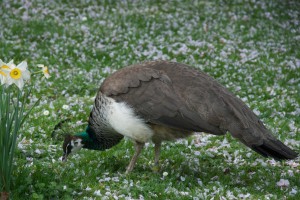Who’s Who in the Animal World
It’s a dangerous world out there, and animals know it. For a social species, being able to alert the group to the presence of a predator is incredibly important, and one of the most common and practical methods of doing this is with a loud, vocal call. But responding to predators takes energy, and in order to assess the reality of a potential threat signal, it would be important to determine the identity (and reliability) of the signaler. Individuals of many animal species, from mice and marmots to birds and baboons, have distinct enough cries that one individual can be distinguished based on acoustics alone in the lab. However, the question is, can the animals tell themselves apart too?
The Experiment
Nichols and Yorzinski kept 33 peahens (Pavo Cristatus, the males of which are the familiar peacock) indoors and subjected them to various calls in order to determine if they are able to distinguish between individuals. Peafowl females use a distinct anti-predator cry in their dense scrubland habitats, described as a “bu-girk,” both to signal danger and during mobbing behavior. Although the exact characteristics of peacock society remain uncharacterized, they might live in groups of up to 18 individuals. As group size is implicated in driving evolution of call individuality, being able to quickly test the reliability of a call would be of the utmost fitness importance.
Kept in isolated cages, each focal peahen was subjected to a habituation call series. This consisted of 10 previously recorded calls all from one individual (‘individual A’) played in random order, until the focal peahen did not respond, as determined by whether or not it opened its eyes at night. Once the bird habituated to individual A’s calls, a ‘stimulus call,’ consisting of either 5 random calls from the same individual A (the control) or a previously unheard individual B, was played. If unable to distinguish the calls, the bird would presumably not respond to the new individual.
Good Hearing
The researchers observed that the peahen does in fact more readily respond to a new individual. This suggests that reliability of a caller is both gauged and recorded by the receiver within peahens. Although they only used females in this experiment, social rank, as well as a potential predator’s nature, are likely conveyed through calls. Their data points to both the complexity and intelligence of social interactions within birds, as multiple streams of information can be conveyed with one auditory signal. Further research will elucidate whether the birds are actually distinguishing between one individual or a group of similar individuals.
Reference:
Nichols, M. R., & Yorzinski, J. L. (2016). Peahens can differentiate between the antipredator calls of individual conspecifics. Animal Behaviour, 112, 23-27.

